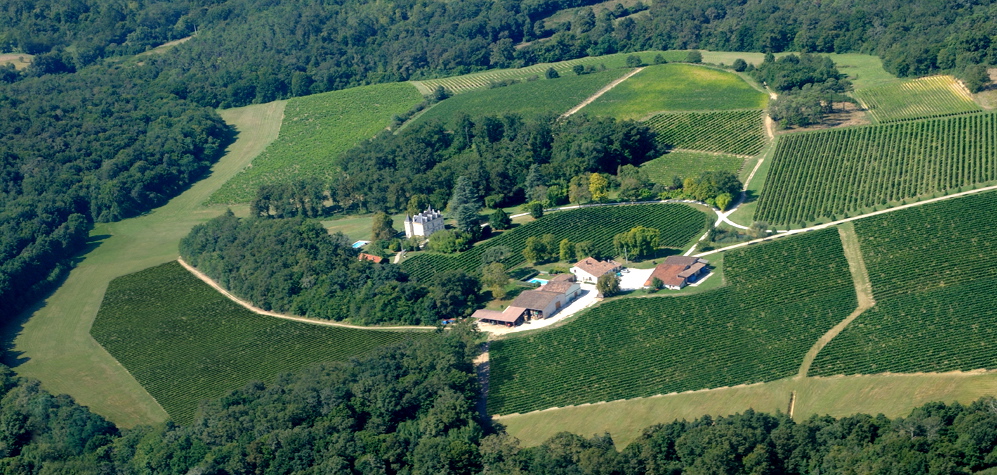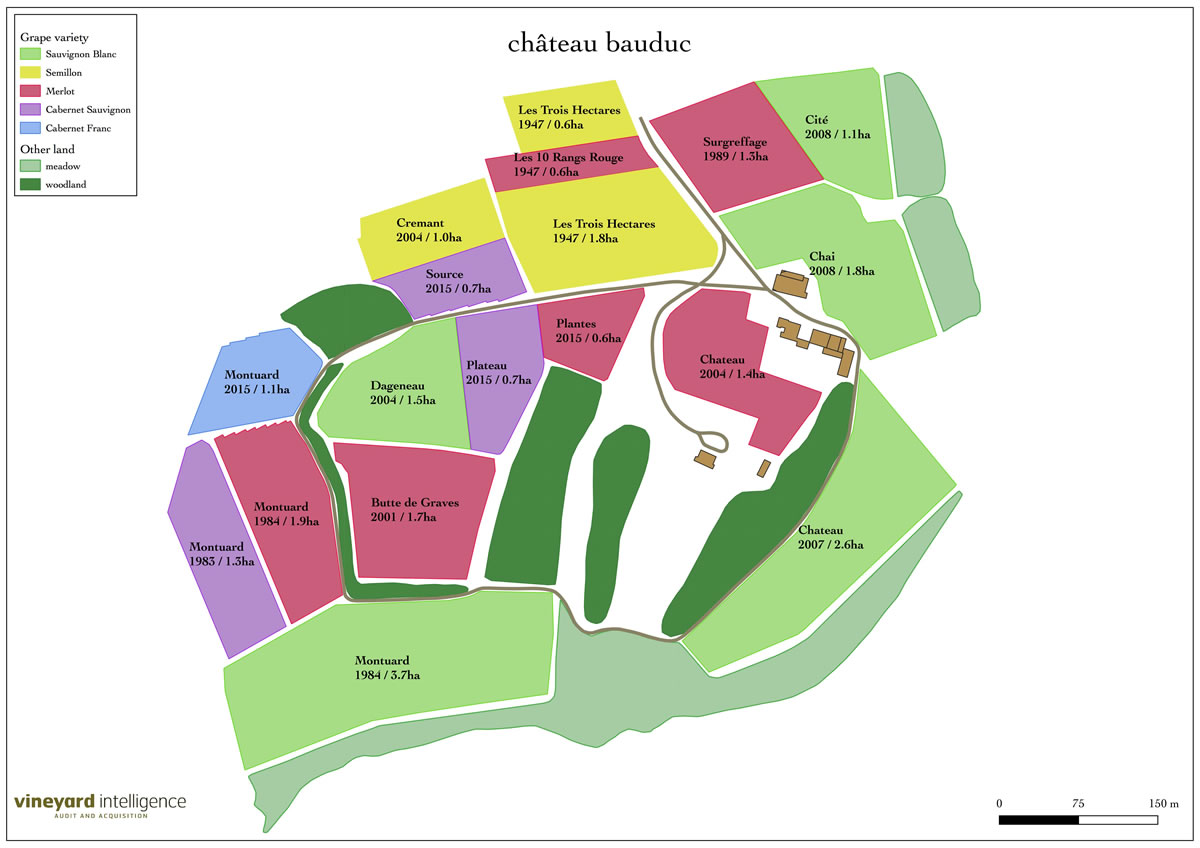
Location
Château Bauduc is a 200-acre estate on the edge of Créon, about 15 miles (25 kms) SE of the city of Bordeaux, 15 miles SW of St-Emilion, 15 minutes north of Cadillac, and 30+ minutes from the airport. We’re on the border of the Entre Deux Mers, Bordeaux Supérieur and Côtes de Bordeaux ’appellations’ and we have 120,000 vines covering 65 acres (a bit over 25 hectares) surrounding the Château in a single block.
Grape varieties
We’re unusual for Bordeaux, which is almost 90% red, because more than half our vines are white - mostly Sauvignon Blanc, some Sémillon. For the reds, we have over two thirds Merlot, plus a few hectares of Cabernet Sauvignon and Cabernet Franc. These are the permitted varieties under the Appellation Contrôlée rules, along with Malbec, Petit Verdot and Carmènere, and we have just a few of these.
A single vineyard
There are 25 acres (10 hectares) of older vines - the oldest date from 1947 - and we've replanted or planted 40 acres (15 or so hectares) more since 2000. The vineyard is on a plateau at the top of a hill with slopes on three sides facing south, east and west. A walk around shows the terrain changing from sandy clay to gravels, especially on the plateau at the top, to a layer of clay over an outcrop of limestone on part of the south and west-facing slopes, and gravelly clay on the east.

The team
We live at the Chateau, where we have an office, with our four children - Georgie, 28 (who helps us with orders and also teaches in London), Sophie, 25, Bugs, 22 in Brighton/London and 19 year-old Tom, who's usually at his Uni, McGill in Montreal, Canada. Daniel and Nelly, meanwhile, have stuck with us since our first harvest in 1999. They do most of the hard work in the vineyard and we employ several seasonal workers like Sandra, Patrick and René for much of the year. We also employ several other staff at busy times.
The growing season
They say that good wine is made in the vineyard. That’s true but the vines don't grow in neat little rows all by themselves - it's extraordinarily labour intensive. From the winter pruning through to the spring budburst and early summer explosion into life, we tend each vine by hand eight or nine times during the growing season, and pass down each row with a tractor-driven bit of kit more than twenty times.
The harvest
Our grapes are picked partly by machine and partly by hand during the September and October harvest. We hire impressive new machines, equipped with clever onboard sorters and de-stemmers and the like, to bring in the grapes at the coolest time of the day before sun rise, to preserve the freshness. Meanwhile, the white grapes for our sparkling Crémant de Bordeaux are hand picked, as are the red grapes for Les Trois Hectares.
The winery
There are 30 stainless steel tanks in which we make the wine, ranging in size from 5,000 litres up to 20,000 litres – each one being chosen to fit the produce from each parcel of vines. Many tanks, or cuves as we call them, were fitted out in 2006 with an automated temperature control system, which allows us to chill down or warm up the fermenting juice or wine. It has proved to be an essential investment.
Making white wine
Our white grapes are picked first, and we leave the freshly-split grapes and the juice together in chilled tanks, to get some flavour from the skins, before we run off the juice and press the skins and the pulp in a large pneumatic press. The juice is then left to settle before we start the fermentation. Most of this takes place in chilled stainless steel cuves but we also ferment some white in new oak barrels.
Making sparkling
There are cheaper ways to make sparkling wine but the little-known Crémant de Bordeaux has to be made using the traditional method like Champagne. Harvesting - in our case, using just Sémillon - is by hand into crates, the grapes whole bunch-pressed and the juice cool fermented. The wine is then put into bottle for a second fermentation, leaving a gentle fizz inside. Our first Crémant was from the 2014 vintage.
Making rosé
Each year we decide in advance which parcels of red will be used for the rosé. Bordeaux rosé is often a by-product of making red wine but in warm, dry years the grapes can get too ripe and high in potential alcohol, so some blocks are harvested early for rosé alone. It’s produced from red grapes - Merlot, Cabernet Franc and Cabernet Sauvignon - but made like a white wine: the juice is quickly run off for minimal skin contact and then cool fermented.
Making red
The red varieties are the last to ripen and the conditions at harvest time often dictate whether we pick by machine or by hand. Both have their advantages but all red grapes are manually checked on our sorting table because, after de-stemming, the whole grape goes into the fermentation tank - skins, pips, the lot. Fermentation takes place in stainless steel tanks, followed by further maceration with the skins, and then pressing.
The barrel cellar
We rebuilt the barrel cellar soon after we arrived here, partly because it was about to fall down; we now age the reds in French oak for 12 months or so, provided the wine merits it. We sometimes blend oak-aged red with wine that's been matured in stainless steel, while Les Trois Hectares red is all aged in French oak barrels. The barrels are used for three to four years in all.
Bottling
We have our own bottling machine but we prefer to use a specialist bottling company to come in and do the whole job with their massive machinery - on the back of a lorry. The company we use perform the ’chateau bottling’ for some of the greatest Bordeaux estates. We use Stelvin screwcaps for our whites and rosé, which are bottled in the January following the vintage, and natural cork for the reds about 18 months after the harvest.
Bottle store
Our cool bottle store at the chateau can house the production of at least two complete vintages if required, although we try to sell enough young whites and rosés before that eventuality is put to the test. We ship our wine to London City Bond to serve our UK customers, and to our Calais warehouse for Brits who want to stock up in France to avoid paying UK duty.
Production
In good years for both quality and quantity, like 2018 and 2019, we make around 200,000 bottles per year. This is higher than the norm in Bordeaux because you're allowed to make more dry white than red per hectare. We are, however, at the mercy of the weather and sometimes catastrophically so: in 2009 and 2013 we lost over half the crop to hailstorms lasting just a few minutes, and a late Spring frost one morning in April 2017 decimated the crop on the lower slopes. Again, we lost almost half the potential harvest - before the season had even begun. So you never know…
